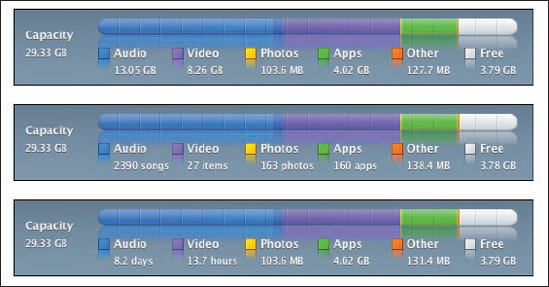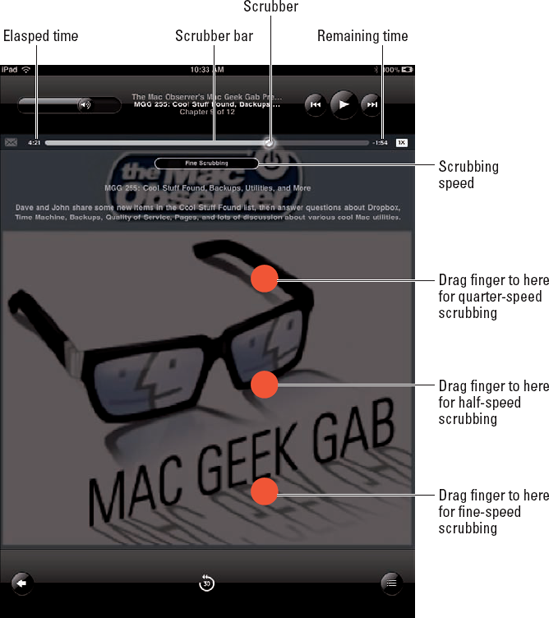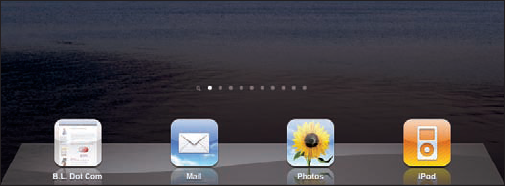Typing faster with the slide and autocorrection
Viewing the iPad's capacity
Altering the speed of scrubbing in iTunes
Sharing links and Web pages
Choosing a Safari home page
Storing your files
Using the iPad as a phone
Capturing what's on-screen
After spending a lot of quality time with our iPads, it's only natural that we've discovered more than a few helpful hints, tips, and shortcuts. In this chapter, we share some of our faves.

Our first tip can help you type faster in two ways. One, it helps you type more accurately; two, it lets you type punctuation and numerals faster than ever before.
Over the course of this book, you find out how to tap, how to double-tap, and even how to double-tap with two fingers. Now we want to introduce you to a new gesture we like to call the slide.
To do the slide, you start by performing the first half of a tap. That is, you touch your finger to the screen but don't lift it. Now, without lifting your finger, slide it onto the key you want to type. You'll know you're on the right key because it changes from one shade of gray to another.
First, try the slide during normal typing. Stab at a key and if you miss, rather than lifting your finger, backspacing, and trying again, do the slide onto the proper key. After you get the hang of it, you'll see that it saves a lot of time and improves your accuracy as well.
Now here's the best part: You can use the slide to save time with punctuation and numerals, too. The next time you need to type a punctuation mark or number, try this technique:
Start a slide action with your finger on the 123 key (the key to the left of the Space key when the alphabetical keyboard is active).
This is a slide, not a tap, so don't lift your finger just yet.
Note
When the punctuation and numeric keyboard appears on-screen, slide your finger onto the punctuation mark or number you want to type.
Lift your finger.
The cool thing is that the punctuation and numeric keyboard disappears and the alphabetical keyboard reappears — all without tapping the 123 key to display the punctuation and numeric keyboard and without tapping the ABC key (the key to the left of the Space key when the punctuation and numeric keyboard is active).
Practice the slide for typing letters, punctuation, and numerals, and we guarantee that in a few days, you'll be typing faster and more accurately.
Note
If you're an iPhone or iPad touch user you may not have noticed that four frequently used punctuation marks — comma, period, exclamation point, and question mark — appear on the iPad alphabetical keyboard in the lower right corner. There's also a fifth very useful punctuation mark — the apostrophe — hidden on your alphabetical keyboard, but you'll have to read the next tip to find out exactly where it is hidden.
Here are two related tips about autocorrection that can also help you type faster and more accurately.
First, before moving on from the subject of punctuation, you should know that you can type dont to get to don't, and cant to get to can't. We've told you to put some faith in the iPad's autocorrection software. And that applies to contractions. In other words, save time by letting the iPad's intelligent keyboard insert the apostrophes on your behalf for these and other common words.
Warning
We're aware of at least one exception. The iPad cannot distinguish between it's, the contraction of it is, and its, the possessive adjective and possessive pronoun. So if you need, say, e-mails to important business clients to be grammatically correct, remember that autocorrect doesn't get it (or it's or its) right all the time.
Tip
In a similar vein, if you ever need to type an apostrophe (for example, when you want to type it's), you don't need to visit the punctuation and numeric keyboard. Instead, press the Exclamation Mark/Comma key for at least one second and an apostrophe magically appears. Slide your finger onto it and then lift your finger, and presto — you've typed an apostrophe without touching the punctuation and numeric keyboard.
Along those same lines, if the autocorrect suggestion isn't the word you want, instead of ignoring it, reject it. Finish typing the word and then tap the x to reject the suggestion before you type another word. Doing so makes your iPad more likely to accept your word the next time you type it and less likely to make the same incorrect suggestion again.
Tip
If you're using a real keyboard (either Apple's Keyboard Dock or a Bluetooth wireless one), you can reject an autosuggestion by pressing the Esc key.
Here you thought you were buying a tech book, and you get grammar and typing lessons thrown in at no extra charge. Just think of us as full-service authors.
When your iPad is selected in the sidebar in iTunes, you see a colorful chart at the bottom of the screen that tells you how your iPad's capacity is being used by your media and other data.
By default, the chart shows the amount of space that your audio, video, and photo files use on your iPad in megabytes (MB) or gigabytes (GB). But you knew that. What you probably don't know is that when you click the colorful chart, it cycles through two more slightly different displays. The first click changes the display from the amount of space used to the number of items (audio, video, and photos) you have stored. Click once more, and the display changes to the total playing time for audio and video, as shown in Figure 18-1.
This is particularly helpful before you go on a trip. Knowing that you have 8.2 days of audio and 13.7 hours of video is far more useful than knowing how many gigabytes you're packing.
The Way-Cool Hidden iTunes Scrub Speed Tip
Here's the situation: You're listening to a podcast or audiobook and trying to find the beginning of a specific segment by moving the Scrubber left and right. The only problem is that the Scrubber isn't very precise and your fat finger keeps moving it too far one way or the other. Never fear — your iPad has a wonderful (albeit somewhat hidden) fix. Just press your finger on the Scrubber (that little round dot on the Scrubber bar), but instead of sliding your finger to the left or right, slide it downward toward the bottom of the screen (see Figure 18-2). As you slide, the scrubbing speed changes like magic and the amount of change is displayed below the Scrubber bar. The default (normal) speed is called hi-speed scrubbing. When you slide your finger downward an inch or two, the speed changes to half-speed scrubbing. Drag another inch or two and it changes to quarter-speed scrubbing. Drag downward to near the bottom of the screen and it changes to fine scrubbing.
Tip
While you're sliding, keep an eye on the elapsed time and remaining time indicators because they provide useful feedback on the current scrubbing speed.
This scrub trick is easier to do than to explain, so give it a try.
The iPad does something special when it encounters an e-mail address or a URL in e-mail messages. It interprets character sequences that look like Web addresses (URLs), such as http://www.WebSiteName.com or www.WebSiteName.com, and any sequences that look like e-mail addresses, such as [email protected]. When the iPad sees what it assumes to be a URL or e-mail address, it appears as a blue link on your screen.
If you tap a URL or e-mail address like the ones just shown, the iPad does the right thing. It launches Safari, takes you to the appropriate Web page for a URL, and starts a new e-mail message for an e-mail address. So don't bother with copy and paste if you don't have to — tap those blue links and the right thing will happen every time.
Here's another cool Safari trick, this time with links. If you press and hold a link rather than tapping it, a little floating text bubble appears and shows you the underlying URL. In addition it offers three options:
Open: Opens the page.
Open in New Page: Opens the page while stashing the current page in one of the nine slots available through the Bookmarks icon, as we describe in Chapter 4.
Copy: Copies the URL to the Clipboard (so that you can paste it into an e-mail message, save it in Notes, or whatever).
Tip
You also see the underlying URL if you press and hold a URL in Mail with buttons to open or copy it. Having this information in Mail is even more useful because it enables you to spot bogus links without switching to Safari or actually visiting the URL.
Finally, here's one last Safari trick. If you press and hold most images, Save Image and Copy buttons appear. Tap Save Image and the picture is saved to the Saved Photos album in the Albums tab of the Photos app; tap Copy and it's copied to the Clipboard so that you can paste it into an e-mail message or document created in another app (such as Apple's Pages or Keynote).
Ever stumble onto a Web page you just have to share with a buddy? The iPad makes it dead simple. From the site in question, tap the + button at the bottom of the browser. Then tap the Mail Link to This Page button that appears on-screen. A mail message appears with the subject line prepopulated with the name of the Web site you're visiting and the body of the message prepopulated with the URL. Just type something in the message body (or don't), supply your pal's e-mail address, and then tap the Send button.
You may have noticed that there's no home page Web site on the iPad version of Safari as there is in the Mac and PC versions of the browser (and for that matter, every other Web browser we know of). Instead, when you tap the Safari icon, you return to the last site you visited.
The trick is to create an icon for the page you want to use as your home page. This technique is called creating a Web clip of a Web page. Here's how to do it:
Open the Web page you want to use as your home page and tap the + button.
Tap the Add to Home Screen button.
An icon that will open this page appears on your Home screen (or one of your Home screens if you have more than one).
Tap this new Web clip icon instead of the Safari icon, and Safari opens to your home page instead of the last page you visited.
Tip
You can even rearrange the icons so that your Home Page icon, instead of or in addition to the Safari icon, appears in the dock (the bottom row that appears on every Home screen), as shown in Figure 18-3.
See the tip in Chapter 1 for rearranging icons if you've forgotten how. And consider moving the Safari icon to a different Home screen so you never tap it by accident. Finally, remember that the Dock has room for six icons even though it only has four by default. So you could, if you like, have both Safari and your new Web clip icon in the Dock so you can tap either one depending upon your needs.
A tiny Massachusetts software company known as Ecamm Network is selling an inexpensive piece of Mac OS X software that lets you copy files from your computer to your iPad and copy files from the iPad to a computer. (No Windows version is available.) Better still, you can try the $19.95 program called PhoneView for a week before deciding whether you want to buy it. Go to www.ecamm.com to fetch the free demo.
In a nutshell, here's how it works. After downloading the software to your Mac, double-click the program's icon to start it. To transfer files and folders to the iPad (assuming that you have room on the device), click the Copy to iPad button on the toolbar, and then select the files you want to copy. The files are copied into the appropriate folder on the iPad. Alternatively, you can drag files and folders from the Mac desktop or a folder into the PhoneView browser.
To go the other way and copy files from your iPad to your computer, highlight the files or folders you want to be copied and click the Copy from iPad button on the toolbar. Select the destination on your Mac where you want to store the files, and then click Save. You can also drag files and folders from the PhoneView file browser onto the Mac desktop or folder. Or, you can double-click a file in the PhoneView browser to download it to your Mac's Documents folder.
If you need access to the files on your iPad, or if you want to use your iPad as a pseudo–hard drive, PhoneView is a bargain.
Many people, including us, have compared the iPad to an iPhone on steroids. Only the iPad isn't actually a phone.
Don't let that stop you from making or even receiving phone calls on the tablet.
Come again?
You read right. You can make and even receive phone calls on your iPad. After all, two of the key components to calling are built into the iPad: a speaker and microphone. Now all you'll have to do is head to the App Store to fetch a third, an app that takes advantage of what's known as VoIP, or Voice over Internet Protocol. In plain-speak, that means turning the iPad into a giant iPhone. And yes, you can find more than one app to do the trick.
We've checked out Skype, Toktumi's Line2 (both iPhone apps as this book went to press), along with Truphone, which has a version for the large iPad screen. The apps themselves are free, although you have to pay for calls to regular phones.
Line2: We especially like Line2, although it costs $15 a month. It can receive calls through Wi-Fi or AT&T's network (if you have the iPad with 3G). It boasts such features as visual voice mail (like the iPhone) and conference calling. And it taps right into your iPad Contacts list.
Skype: Skype's app permits free Skype-to-Skype calls; calls to regular phones around the world cost pennies per minute.
Truphone: This app permits free Wi-Fi calls to Truphone and Google Talk users. Other rates are cheap.
True confession: We threw in this final tip because, well, it helps people like us.
Permit us to explain. We hope you've admired the pictures of the iPad screens that are sprinkled throughout this book. We also secretly hope that you're thinking what marvelous photographers we must be.
Well, the fact is, we couldn't take a blurry picture of the iPad using its built-in (and undocumented) screen-grab feature if we wanted to.
Press the Sleep/Wake button at the same time you press the Home button, but just for an instant. The iPad grabs a snapshot of whatever is on the screen.
The picture lands in the Saved Photos album in the Albums tab of the Photos app; from there, you can synchronize it with your PC or Mac, along with all your other pictures, or e-mail it to yourself or anyone else. And from there, the possibilities are endless. Why, your picture could wind up just about anywhere, including in a For Dummies book.



